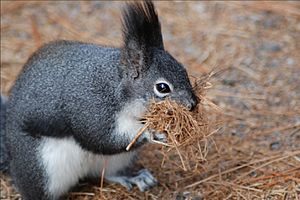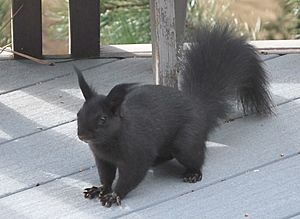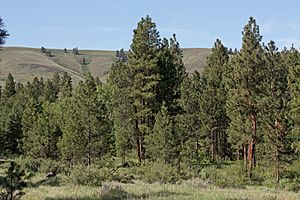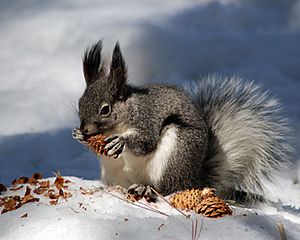Abert's squirrel facts for kids
Quick facts for kids Abert's squirrel |
|
|---|---|
 |
|
| Conservation status | |
| Scientific classification | |
| Genus: |
Sciurus
|
| Species: |
aberti
|
| Subspecies | |
|
|
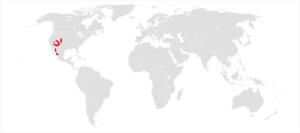 |
|
| Abert's squirrel's range | |
The Abert's squirrel is also known as the tassel-eared squirrel. Its scientific name is Sciurus aberti. This type of tree squirrel lives in the southern Rocky Mountains, stretching from the United States down to northern Mexico. You can find many of them in Arizona, the Grand Canyon, New Mexico, and southwestern Colorado.
Abert's squirrels mostly live in forests with mature ponderosa pine trees. They are named after an American naturalist, John James Abert. These squirrels are easy to spot because of their unique tufted ears, gray fur, light-colored belly, and a reddish patch on their lower back. They mainly eat seeds and cones from ponderosa pine trees. But they also enjoy fungi, tree buds, bark, and even dead animals. They usually have their babies in the summer, building round nests high up in the trees.
Contents
Who is Abert's Squirrel Named After?
Abert's squirrel is named after Colonel John James Abert. He was an American naturalist and military officer. In the 1800s, he led a group called the Corps of Topographical Engineers. Their job was to map the American West.
What are Abert's Squirrels Like?
Abert's squirrels are about 18 to 23 inches (46–58 cm) long. Their tail adds another 7 to 10 inches (19–25 cm) to their length. The most special thing about them is their ear tufts, which are like little brushes of hair sticking up 1 to 2 inches (2–3 cm) from each ear. This makes them look a bit like the Eurasian red squirrel.
They usually have a gray coat with a white belly. They also have a clear rusty or reddish stripe down their back. Some Abert's squirrels in the Colorado Rocky Mountain foothills can even be completely black!
Where Do Abert's Squirrels Live?
Abert's squirrels live in the Colorado Plateau and the southern Rocky Mountains. This area includes parts of Colorado, Utah, Arizona, and New Mexico. Their home range also goes south into Mexico, in places like Chihuahua and Durango. They can even be found a short distance into Wyoming where ponderosa pine trees grow.
Scientists have moved some Abert's squirrels to other areas in Arizona. These squirrels have successfully started new groups there.
There are nine different types, or subspecies, of Abert's squirrel. Each subspecies lives in a specific area where ponderosa pine forests are found. Here are some of them:
- S. a. aberti – lives in northern Arizona.
- S. a. barberi – found in northwestern Chihuahua, Mexico.
- S. a. chuscensis – lives near the New Mexico-Arizona border.
- S. a. durangi – found in Durango, Mexico.
- S. a. ferreus – lives in the Rocky Mountains of central Colorado.
- S. a. kaibabensis – this is the famous Kaibab squirrel from the Kaibab Plateau in northern Arizona.
- S. a. mimus – found near the New Mexico-Colorado border.
- S. a. navajo – lives in southeastern Utah.
- S. a. phaeurus – found in parts of Durango and Chihuahua, Mexico.
What Kind of Home Do They Like?
In the United States, Abert's squirrels almost always live in ponderosa pine forests. These trees provide them with shelter, places to build nests, and food. In Mexico, where ponderosa pines are not common, they live in forests of a similar tree called Pinus arizonica.
The best homes for Abert's squirrels are ponderosa pine forests with trees of different ages. They like areas where some trees are very tall and old. These older trees produce the most cones, which means more food for the squirrels.
Abert's squirrels usually have a home range of about 10 to 24 acres (4 to 10 hectares) in the summer. Their ranges might be a bit smaller in winter.
What Plants Are Around Them?
Abert's squirrels are very closely linked to cool, dry ponderosa pine forests. In Arizona, these forests are usually found at high elevations, between 5,500 and 8,500 feet (1,676 and 2,591 meters).
They live in pure ponderosa pine stands. Sometimes, other trees grow alongside the ponderosa pines. These can include Gambel oak (Quercus gambelii), Colorado pinyon (Pinus edulis), junipers (Juniperus species), quaking aspen (Populus tremuloides), and Douglas fir (Pseudotsuga menziesii).
In Mexico, the ponderosa pines where these squirrels live are now often called different species. These include Pinus arizonica and Pinus cooperi.
Are Abert's Squirrels Endangered?
The International Union for the Conservation of Nature (IUCN) says that Abert's squirrel is a "least concern" species. This means they are common and not in danger of disappearing.
However, in Mexico, many of their forest homes have been cut down. Because of this, the Mexican environmental agency considers them 'vulnerable' and protects them.
How Do Abert's Squirrels Live?
Abert's squirrels are diurnal, which means they are active during the day. They often start moving a little before sunrise and stay active throughout the day. They usually go back to their shelters before sunset. Unlike some other North American squirrels, Abert's squirrels do not store food for later.
The main reasons Abert's squirrels might die are not having enough food or getting injuries, like broken teeth, that make it hard for them to eat.
How Do They Have Babies?
In central Arizona, Abert's squirrels usually breed from May to June. The young squirrels are in the nest from June to July. Abert's squirrels are pregnant for about 46 days. A mother squirrel usually has two to five babies in a litter, but three or four is most common.
When they are born, young Abert's squirrels have no hair, and their eyes and ears are closed. After about two weeks, they start to grow thin hair, and their ears open a little. By six weeks, their fur is fully grown, and their eyes are open. At seven weeks, their tail gets wider and they hold it over their back. They also start to eat mushrooms and bark.
Young squirrels first leave the nest at about seven weeks old. They don't go down to the ground until they are about nine weeks old. By ten weeks, they are no longer drinking milk from their mother. They reach their full size by 15 to 16 weeks. Female Abert's squirrels usually have only one litter of babies each year. However, in the warmer southern parts of their range, they might have two litters.
Where Do They Build Nests?
Female Abert's squirrels build their nests using pine twigs. These twigs are usually about 0.5 inches (1.3 cm) thick and 6 to 24 inches (15–61 cm) long. They line their nests with different soft materials.
In summer, Abert's squirrels build nests on ponderosa pine branches. They also use holes in Gambel oak trees. Sometimes, they even build nests in cottonwood tree branches. Ponderosa pines usually don't have holes big enough for Abert's squirrels.
Most nests are built in the upper part of the tree, high above the ground. They are often placed on a large branch close to the tree trunk. Nests are usually built on the south or southeast side of the tree. Abert's squirrels often build their nests in groups of trees where the branches touch each other. They sometimes use "witches brooms" – bushy growths caused by a plant disease – to help support their nests.
The nests are generally round. They often have a small platform sticking out from one side. Most Abert's squirrels use these nests all year round for shelter at night. However, mothers might move their babies to a bigger nest when the young are 3 to 6 weeks old. In winter, two Abert's squirrels, usually a mother and one of her young, might share the same nest for warmth.
What Do They Eat?
Abert's squirrels eat ponderosa pine trees all year. They love the seeds the most. They also eat the inner bark, especially from young twigs. Other foods include tree buds, pollen cones, and fleshy fungi. They even eat dead animals, bones, and antlers!
Ponderosa pines produce a lot of cones every 3 to 4 years. About once every four years, there are almost no cones. Abert's squirrels start eating immature seeds soon after cones begin to grow in late May. They continue eating seeds through the summer as the cones get ripe. A single squirrel might eat seeds from up to 75 cones in a day when seeds are their main food.
When seeds fall from the cones in October and November, Abert's squirrels keep eating seeds from late-ripening cones. They also pick up single seeds from the ground. The soft inner bark of twigs is eaten all year, but especially in winter. A squirrel might eat about 45 twigs a day in winter. After the seeds are gone, from November to April, inner bark becomes the main part of their diet. They also like the soft inner part of small tree buds. In May, they eat male buds and cones, and young ovules if they are available.
Abert's squirrels also eat fleshy fungi, like mushrooms. They can eat mushrooms that are poisonous to humans without getting sick.
They get most of their water from the food they eat. But sometimes, they will drink from ponds or puddles after it rains.
Who Hunts Abert's Squirrels?
Northern goshawks (a type of hawk) might hunt enough Abert's squirrels to control their numbers. Other hawks also prey on Abert's squirrels in Arizona. Even though other animals like gray foxes, bobcats, and coyotes are around, there isn't much proof that they hunt Abert's squirrels.
![]() This article incorporates public domain material from the United States Department of Agriculture document "Sciurus aberti".
This article incorporates public domain material from the United States Department of Agriculture document "Sciurus aberti".
See also
 In Spanish: Ardilla de Abert para niños
In Spanish: Ardilla de Abert para niños



